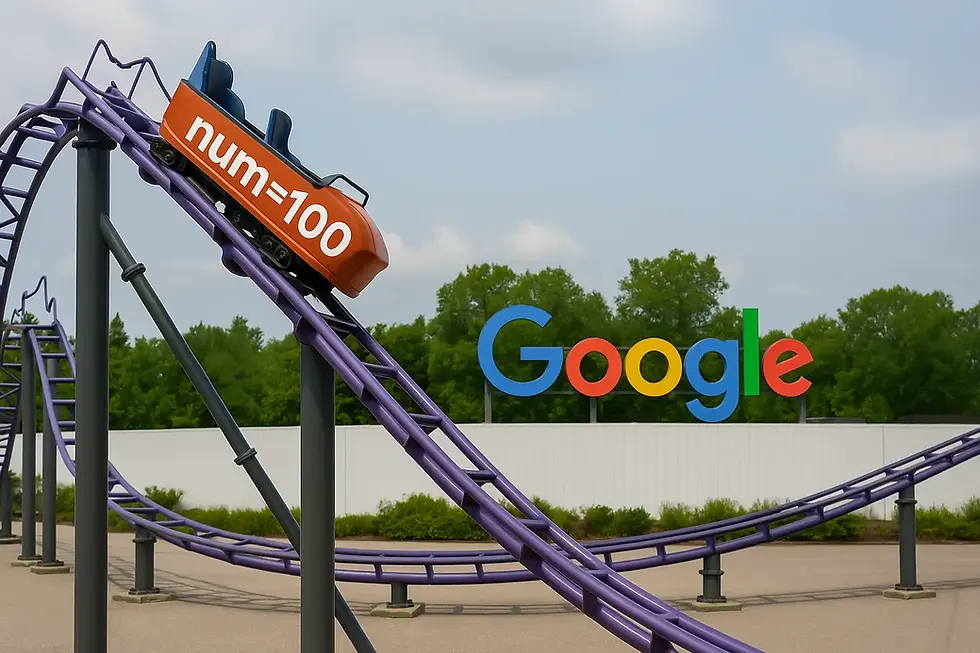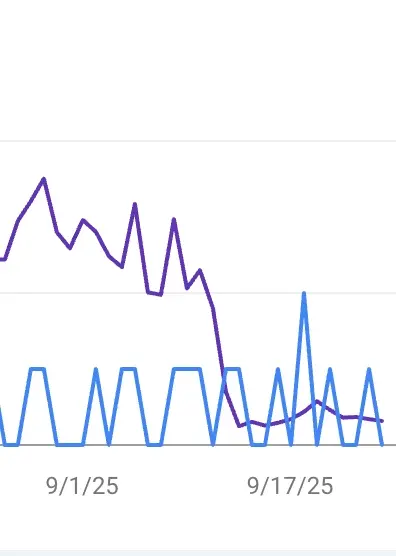When Google Took Away num=100: Why Your Search Console Impressions Fell Off a Cliff September 14
- Kyle Senger
- Sep 18
- 5 min read

Wait, Where Did My Impressions Go?
If you’ve been poking around in Google Search Console and saw your search impressions drop suddenly around September 14, you’re not alone. At first glance, it feels like something went horribly wrong, maybe a penalty, maybe a sudden disappearance from search results, maybe your competition just launched a million-dollar SEO campaign overnight.
Even in our own data at Unalike Marketing, we spotted the culprit: Google quietly retired a tiny little parameter called num=100. And with that, our Search Console reports changed forever.
It sounds like the plot twist in a nerdy spy movie, but the truth is both more boring and more interesting than you might expect.
What the Heck Was num=100 Anyway?
For years, you could tell Google’s search engine to show 100 results on a page instead of the default 10 by tacking &num=100 onto the search URL. Nerds, SEOs, and reporting tools loved it because it meant pulling bigger chunks of data in one go.
Example:
Default search results = 10 listings per page
&num=100 results = 100 listings per page
Simple enough.
Except now, it’s gone. Google pulled the plug earlier this year, quietly confirming that the num=100 setting no longer does anything. Every query is back to showing results in batches of 10.
Why Did Impressions Drop on September 14?

The Google Search Console impressions drop on September 14 wasn’t random. That’s the day Google retired the num=100 parameter.
The official reason: consistency. Google likes standardization and doesn’t want to maintain weird exceptions that only power users ever knew about.
The unofficial reason: probably server efficiency. Why waste resources generating and tracking impressions on results no one actually clicks? Either way, RIP num=100.
How This Affects Your Google Search Console Metrics
Here’s where it gets juicy. When your SEO tool, or even Google Search Console itself, used num=100, impressions were counted much more broadly. Your page could appear as impression 87 and it would get logged.
Now that the num=100 view is gone, the only impressions counted are the ones that show up in the standard 10-per-page layout. If you’re buried on page 9 or 10, congratulations: you’re invisible. So overnight, impression counts fell dramatically.
Did your SEO suddenly fail? Nope. Did your content vanish? Also nope. You’re just seeing a more “realistic" (or maybe “less padded”) picture of what users actually see.
The Vanishing Hockey Stick: A Real Example
For years, impressions in Search Console gave us that classic “hockey stick” graph, up and to the right. And as Canadians, we loved it. Who doesn’t want their performance have a faint resemblance to Connor McDavid.

But here’s the kicker: when num=100 disappeared, that hockey stick snapped in half. Across many accounts, we saw Google Search Console impressions drop by 70–80% overnight after September 14.
Take one client example (rounded for easy math):
August: 120,000 impressions, 1,200 clicks
September (post-num=100): 32,000 impressions, 1,180 clicks
Looks terrifying at first, right? Impressions cratered. But look closer, clicks stayed almost identical and so would your traffic in Google Analytics.
Why? Because those extra 88,000 “lost” impressions were buried so far down in the results they were never going to generate real traffic. What disappeared was the illusion of visibility, not the actual visits to the site.
Why This is a Problem for Vanity Reporting
This is the fun part: if you’ve been paying an agency that brags about “look how many impressions we delivered this month,” their reporting is about to look bleak.
Old days with num=100: Agencies could pad reports with lots of low-value impressions.
Today: Only the top 10 results per page count. If you weren’t climbing high, you weren’t really being seen anyway.
It’s a classic case of metrics versus meaning. Impressions don’t pay the bills. Clicks and conversions do. If an agency’s “success” hinged on climbing from the 89th spot to the 64th, this change exposes the fluff. It’s a new era where vanity metrics go to die.

Does This Change Your Actual Organic Performance?
Short answer: not really.
Let’s be honest, no one scrolls to the 100th result. By the time someone hits page 2, they’re already muttering to just rephrase their search. Google itself has joked that the best place to hide a dead body is on page 2 of search results.
So if you were sitting at position 83 for “best used car in Saskatoon,” those impressions were more like sympathy views. They never turned into clicks. Your organic performance (real clicks, traffic, leads) hasn’t changed. Only the illusion of reach has.
What You Should Focus On Instead
Since impressions are now a leaner metric, here’s where your focus should shift:
Click-through rate (CTR): How many people actually click when you show up?
Ranking distribution: Are you cracking page one consistently?
Traffic & conversions: The only numbers that actually tie to your business goals.
Content quality: Google keeps tightening the screws on relevance and helpfulness, content that actually answers questions will outrank keyword-stuffed fluff.
How Agencies and Tools Are Scrambling
If you rely on third-party SEO platforms, you may have already seen dashboards light up with warnings about this change. Many of them depended on num=100 to quickly pull bulk data. Now they’re either:
Reporting “drops” that aren’t real.
Restructuring their pipelines to scrape in smaller increments.
Explaining awkwardly to clients why impressions are suddenly lower.

The truth is, agencies that built their pitch on delivering X million impressions will need a new song to sing.
This update forces everyone—agencies, brands, and solo site owners—to stop obsessing over numbers that don’t actually matter.
Think of it this way: before, you were counting how many people might have maybe, sort of, possibly scrolled far enough to see you. Now, you’re counting how many people actually saw you in a realistic browsing environment.
It’s cleaner data, and it frees you up to focus on things that make a difference. And truly that’s a good thing.
Key Takeaways
Google retired num=100 and instituted num=10 for everyone on September 14, causing the sudden Google Search Console impressions drop.
Impressions in Search Console and SEO tools will look smaller because far-down results aren’t logged.
Your organic traffic hasn’t actually dropped, it just looks different on paper and your clicks shouldn't really be affected.
Agencies that relied on bloated impression counts will need to adapt.
The real focus should be clicks, rankings, and conversions.
Final Word: Don’t Panic
Yes, your Search Console charts probably look like they got pushed off a cliff. But no, your SEO isn’t doomed. You didn’t suddenly lose 70% of your visibility, it just wasn’t real visibility to begin with.
So don’t mourn the loss of num=100. Pop open a page-one strategy instead. Because if you’re not on the first page, you may as well be in witness protection.
And if your current agency is scrambling for excuses instead of solutions, maybe it’s time to talk to one that prioritizes honesty and transparency in their reporting. At Unalike Marketing, we cut through the fluff, keep the metrics real, and focus on strategies that actually move the needle.
Book a free consultation with Unalike Marketing and see how refreshing straightforward reporting can be.

About the Author
Kyle Senger
Kyle Senger is the Founder and Lead Strategist of Unalike Marketing, a Saskatchewan-based agency that helps small and medium-sized businesses cut through digital confusion with honest, data-driven marketing. With nearly 20 years of experience, Kyle specializes in SEO, content strategy, and analytics, translating complex changes (like Google’s retirement of the num=100 parameter) into practical insights businesses can actually use. His focus is on transparent reporting and strategies that drive real growth, not vanity metrics.







Comments